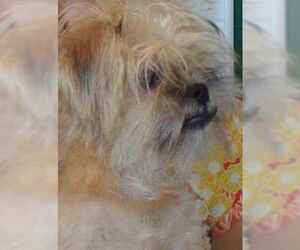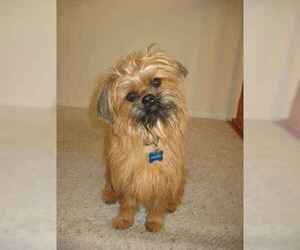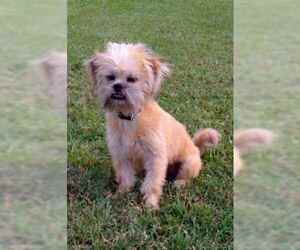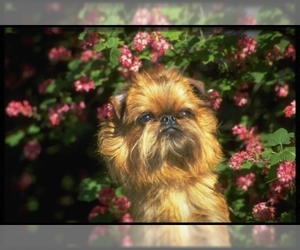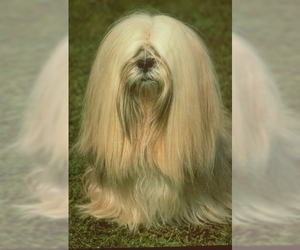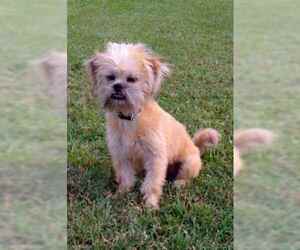
All about Lhaffon dog breed
A.K.A. :Lhaffon Terrier, Lhaffon Griffon, Lhaffon Apso, Griffon Apso, Apso Griffon, Lhasa Griffon, Griffon Lhasa, Brussapso, Brusspo, Griffapso, Lhaf Griff, Brussels Lhasa, Lhasa Brussels, Griffon Lhaffon
Lhaffon is a mix of
Size
Grooming requirements
Exercise requirements
Good with other dogs
Watchdog ability
Energetic
Training requirements
Playful
Affectionate
Good with other pets
Good with children
Good with strangers
Winter
Summer
Healthiness
Protective
Life Span
| Mixed Breeds | Member |
| Breeds A - Z | L |
| Breeds by Group | Companion Non-Sporting Toy |
| Breeds by Trait | Hypoallergenic Low Shedding |
| Overview: | The Lhaffon is an enchanting hybrid, a delightful cross between the spirited Brussels Griffon and the dignified Lhasa Apso, originating from the desire for a companion dog with a charming personality and manageable size. Physically, they are typically small, weighing between 8-15 pounds, with a luxurious, often shaggy coat that can vary in color and requires regular grooming to prevent matting. Their expressive eyes and often bearded muzzle give them a unique and endearing appearance. Temperamentally, Lhaffons are known for being affectionate, intelligent, and surprisingly playful, often displaying a confident and alert nature inherited from their Lhasa Apso lineage, combined with the Griffon's vivaciousness. They are generally good with families and can adapt well to apartment living, provided they receive adequate daily exercise and mental stimulation. While generally robust, potential health considerations include luxating patella, respiratory issues (due to their brachycephalic Griffon parentage), and eye conditions. Early socialization and consistent training are key to ensuring a well-adjusted Lhaffon companion. |
F.A.Q.
All You Need to Know About the "Lhaffon" Breed (parent breeds: "Brussels Griffon" × "Lhasa Apso")
Meet the charming Lhaffon, an enchanting designer breed combining the spirited Brussels Griffon with the devoted Lhasa Apso. Originating from a desire for a companion dog with character, the Lhaffon typically exhibits a delightful blend of their parents’ best traits. Expect a loving and alert temperament; they are often playful yet possess a dignified calm. Physically, the Lhaffon is a small-to-medium sized dog, usually sporting a scruffy, wiry, or long double coat that comes in various colors, requiring moderate grooming—think weekly brushing to prevent mats. Their compact size makes them ideal for apartment living and they adapt well to families, though early socialization is key. Daily walks and indoor play suffice for their moderate exercise needs. Common health considerations, similar to their parent breeds, can include patellar luxation or eye conditions, making a reputable breeder crucial. The Lhaffon is an intelligent and affectionate companion, perfect for those seeking a unique, engaging, and relatively low-maintenance furry friend.The average weight for an adult Lhaffon typically falls between 10 to 18 pounds. This range represents a healthy weight for Lhaffon. While there can be individual variations, male Lhaffons often trend towards the higher end of this range, and females towards the lower to middle. This Lhaffon weight information provides a good indication of their typical average size.
Wondering about the Lhaffon height? You're in the right place! As a charming crossbreed of the Brussels Griffon and the Lhasa Apso, the average size of a Lhaffon typically falls into the small to medium range, making them a great fit for various living situations.
Most adult Lhaffons stand between 8 to 12 inches tall at the shoulder. This range gives you a good idea of how tall is a Lhaffon when fully grown. It's important to remember that, like with all mixed breeds, there can be some natural variation. Factors like which parent breed your Lhaffon takes after more, as well as individual genetics, can influence their final height.Generally, you might find slight differences in Lhaffon height based on gender, with males sometimes being a touch taller or more robust than females, though this isn't a strict rule for the breed. Overall, you can expect a sturdy, compact companion that's perfectly sized for cuddles and adventures!The Lhaffon breed, a charming mix of Brussels Griffon and Lhasa Apso, displays a delightful array of Lhaffon colors. While specific AKC recognized Lhaffon colors are not formally established for this hybrid, we can infer common and rare coat types based on its parent breeds.Commonly seen Lhaffon colors include shades of red (often referred to as fawn or sable), black, cream, white, and various combinations like parti-color (patches of color on white). These are generally accepted and sought after. You'll also find brindle Lhaffon coats, a beautiful striped pattern, often in black and red variations.For those seeking exotic Lhaffon variations or rare Lhaffon colors, certain genetic expressions can appear. These might include chocolate (a rich brown), blue (a dilute black), and even lilac (a dilute chocolate), though these are less common and may command a higher price due to their rarity. Keep in mind that patterns like merle are not typically found in the parent breeds and are extremely unlikely to occur naturally in a Lhaffon, and if present, should be carefully investigated due to potential health concerns associated with irresponsible breeding. When considering Lhaffon colors for adoption, remember that coat type can sometimes influence price, with rare coat types often being more expensive.
Lhaffon Personality & TemperamentThe Lhaffon, a charming blend of the Brussels Griffon and Lhasa Apso, typically inherits a delightful and complex personality. Expect a loyal and affectionate companion who often forms a strong bond with their primary caregiver. They are generally quite friendly with their family, often expressing their love through cuddles and playful antics.Regarding sociability, Lhaffons can be a bit reserved with strangers initially, echoing the Lhasa Apso’s protective nature. Early socialization is crucial to encourage a more outgoing disposition. They are generally adaptable to apartment living due to their smaller size, provided they receive regular mental stimulation and short walks.When it comes to behavior with children, Lhaffons can be good family pets, especially with older, respectful children who understand how to interact gently with small dogs. Supervision is always recommended. Their interaction with other pets can vary; they may do well with other calm, well-socialized animals, but their assertive Griffon side might occasionally emerge. They possess a good degree of intelligence and can be quite spirited, requiring consistent and positive training. Overall, the Lhaffon temperament is one of a devoted, intelligent, and sometimes spirited companion who thrives on companionship and a consistent routine.
The Lhaffon temperament is a delightful blend, creating a charming and affectionate companion dog. They are generally very friendly and sociable, often forming strong bonds with their families and exhibiting deep loyalty. Highly adaptable, Lhaffons are well-suited for apartment living, provided they receive regular short walks and indoor play. Their intelligence, inherited from both parent breeds, makes them responsive to training, though they can sometimes display a charming hint of stubbornness, requiring consistent, positive reinforcement. Lhaffons are typically good with children who are taught to interact gently, and can get along well with other pets, especially when socialized from a young age. They thrive on human companionship and can be quite sensitive to their owners' moods, often offering comfort. This breed's personality traits include being alert, playful, and affectionate, making them wonderful, engaging additions to most households.
Lhaffon Care: Your Lhaffon, a delightful mix of Brussels Griffon and Lhasa Apso, requires specific daily maintenance to thrive. Their beautiful coat needs regular attention; expect daily brushing to prevent mats and tangles, with professional grooming every 6-8 weeks for trimming and shaping. Due to their brachycephalic (short-nosed) anatomy, Lhaffons are a low-energy dog breed. Short, moderate walks once or twice daily are sufficient to meet their exercise needs. Over-exertion, especially in warm or humid weather, can lead to breathing difficulties. Their diet should consist of high-quality small-breed dog food, carefully portioned to prevent obesity – a common health concern. Regular dental care for Lhaffon is crucial; daily brushing with dog-specific toothpaste helps prevent periodontal disease. Check and clean their facial wrinkles daily to avoid skin fold dermatitis, and inspect and clean their ears weekly to prevent infections. Climate sensitivity for Lhaffon is significant; they are prone to overheating in heat and struggle in extreme cold. Keep them indoors in air conditioning during summer and provide warm clothing in winter. Common health tips for Lhaffon include monitoring for skin issues (allergies, hot spots) and maintaining a healthy weight. Early veterinary check-ups are key to addressing potential breed-specific health concerns.
Lhaffon Activity Level: The Lhaffon, a delightful mix of Brussels Griffon and Lhasa Apso, typically exhibits a moderate activity level, balancing playful bursts with a love for lounging. They are not overly energetic but do require consistent, gentle exercise to stay healthy and happy.
Typical Energy Levels & Daily Exercise Needs: Lhaffons have a moderate energy drive, meaning they'll enjoy short, engaging activities rather than prolonged, intense workouts. Daily exercise needs are met with two to three short walks (15-20 minutes each) and dedicated playtime. These intelligent dogs also thrive on mental stimulation, so incorporating puzzle toys or training sessions into their routine is beneficial.Playtime Preferences: Expect your Lhaffon to enjoy interactive playtime. They love chasing toys, engaging in gentle tug-of-war, and snuggling on the couch after a good play session. Their affectionate nature means they also relish attention-based games with their family.Limitations Due to Brachycephalic Anatomy: As a brachycephalic (short-nosed) breed, Lhaffons are prone to overheating and respiratory distress, especially in warm weather or during strenuous exercise. It’s crucial to keep walks short and at cooler times of the day, always provide fresh water, and avoid over-exertion. Watch for signs of heavy panting or discomfort, and never leave them unsupervised in hot environments.Balancing Energy and Rest: Lhaffons beautifully balance short bursts of energy with long periods of rest. They'll enthusiastically participate in activities, then happily curl up for a nap, often on a comfortable lap. This makes them adaptable companions.Suitability for Households: Are Lhaffon suitable for active families or low-energy households? Lhaffons are an excellent fit for low-to-moderately active families or individuals who appreciate a dog that enjoys both play and relaxation. While they can keep up with gentle family activities, they are not ideal for highly athletic households seeking a running or hiking companion. Their adaptability also makes them suitable for apartment living, provided their daily exercise and mental stimulation needs are met. If you're looking for a charming, affectionate dog with manageable exercise requirements, the Lhaffon could be your perfect match.Because both parent breeds can have shortened muzzles, many Lhaffons inherit brachycephalic features, making them prone to Brachycephalic Obstructive Airway Syndrome (BOAS). Applying brachycephalic dog care strategies—such as avoiding strenuous activity in hot weather, using a harness instead of a collar, and monitoring breathing during exercise—can help reduce respiratory stress. Their compact build and heavy coats also contribute to heat sensitivity, so they should always have access to shade, water, and cool resting areas. Additionally, their body structure may predispose them to spinal problems such as arthritis or intervertebral disc disease, particularly if they jump frequently from heights or carry excess weight.
Understanding how to keep Lhaffon healthy involves scheduling regular veterinary checkups, early screening for joint, respiratory, and skin conditions, maintaining a balanced diet to prevent obesity, and providing moderate but consistent exercise. Grooming routines should include brushing to prevent matting, cleaning skin folds, checking ears for infection, and dental care to reduce oral disease. With attentive care, Lhaffons can enjoy a playful, affectionate life of 12–15 years.
Breed Breakdown: What Experts Say About the Lhaffon
I'd rate the "Size" trait of the "Lhaffon" breed a 4.The Lhaffon, being a mix of the Brussels Griffon and the Lhasa Apso, will generally be a small to medium-small dog. The Brussels Griffon is quite tiny, typically weighing between 8-12 pounds, while the Lhasa Apso is a bit more substantial, often weighing 12-18 pounds. This genetic blend suggests a Lhaffon would likely fall within the 10-20 pound range, with a height somewhere around 9-12 inches at the shoulder. They'd have a sturdy, compact build, inherited from both parents, but not be overly delicate. Compared to other companion dogs, they're definitely on the smaller side, fitting comfortably in a lap. This makes them exceptionally well-suited for apartment living, as their moderate energy levels and small stature don't demand vast spaces. Their manageable size also makes them excellent travel companions, fitting easily into airline carriers and small vehicles. They are an ideal choice for households with space constraints, offering all the joy of a canine companion without needing a large yard or sprawling home.
The Lhaffon, a mix of the Brussels Griffon and Lhasa Apso, likely falls around a 7 for grooming requirements. This is a moderately high-maintenance breed.The Lhasa Apso contributes a dense, long, double coat that is prone to matting and requires daily brushing to prevent tangles. It's also a low-shedding breed, but this doesn't mean no shedding; rather, the shed hair gets trapped in the coat, necessitating more frequent brushing to remove it. The Brussels Griffon, depending on its coat variety (smooth or rough), can add to this. If the Brussels Griffon parent was rough-coated, the Lhaffon's coat might be wiry and require hand-stripping in addition to brushing to maintain its texture. Both parent breeds are prone to tear staining due to their brachycephalic (short-nosed) features, which means regular cleaning around the eyes will be necessary to prevent irritation and discoloration. Ear cleaning will also be important, as their long, pendulous ears can trap moisture and debris, increasing the risk of ear infections. Nail trimming will be a standard weekly to bi-weekly task, as with most dogs. While neither parent breed is notoriously prone to severe skin issues, the dense coat of the Lhasa Apso side can sometimes mask underlying skin problems if not properly groomed, and potential allergies could exacerbate skin conditions. Overall, the Lhaffon will demand frequent and dedicated grooming, including daily brushing, regular bathing, and attention to specific areas like eyes and ears, making it a more involved grooming commitment compared to many other companion dogs.
I would rate the Lhaffon's exercise requirements at a 4 out of 10.This hybrid breed inherits a moderate energy level from both parent breeds, leaning towards a more relaxed disposition. While they aren't couch potatoes, they are far from being endurance athletes. Daily walks of 20-30 minutes, combined with indoor playtime, are typically sufficient to keep them physically healthy and mentally stimulated. Their brachycephalic anatomy, inherited from both the Brussels Griffon and Lhasa Apso, means they are susceptible to respiratory issues, especially in hot or humid weather, which limits their tolerance for sustained, vigorous movement. They're more suited to short bursts of activity and leisurely strolls rather than long hikes or intense agility training. While they do enjoy playtime and can benefit from some structured routine, they thrive with relatively minimal activity and are quite content with a less demanding lifestyle, making them suitable companions for individuals who can't commit to extensive exercise.
I'd rate the Lhaffon's watchdog ability a strong 8 out of 10.The Lhaffon inherits a potent combination of vigilance from its parent breeds. The Brussels Griffon, despite its small size, is known for being surprisingly alert and quick to bark at anything unusual, possessing a "big dog" attitude in a tiny package. The Lhasa Apso, on the other hand, was historically bred as a sentinel dog for Tibetan monasteries, prized for its keen senses, territorial nature, and distinct, often insistent, bark when strangers approached. This means the Lhaffon is likely to be highly attuned to its surroundings, noticing and reacting to unfamiliar sounds or people entering its perceived territory. Its barking behavior would likely be frequent and assertive when it perceives a threat or unusual activity, serving as an excellent early warning system. While not typically aggressive, its territorial instincts would prompt it to vocally deter intruders, making it far more than just a passive companion. It would certainly provide meaningful early warnings in a home environment, making its presence known and alerting its owners to potential issues.
I'd rate the "Good with Other Dogs" trait of the Lhaffon a 6 out of 10.Lhaffons inherit a mix of personalities from their parent breeds, which can lead to variability in their sociability with other dogs. The Brussels Griffon side is often quite playful and can be good with other canines, though they can also be prone to a "big dog in a small body" syndrome, potentially not backing down from larger dogs if feeling threatened or overconfident. The Lhasa Apso, on the other hand, can be more reserved, independent, and sometimes possessive, which might translate to less enthusiasm for sharing attention or resources with other dogs.Therefore, a Lhaffon's success in a multi-dog household or around unfamiliar dogs heavily depends on early and consistent socialization. They generally aren't inherently aggressive, but their independent streak and potential for possessiveness mean they aren't always immediately welcoming. With proper introductions and training, especially regarding resource guarding, they can coexist peacefully and even form strong bonds with other dogs. However, they might not be the life of the dog park, preferring the company of familiar canine companions over constant interactions with strangers. They can adapt to dogs of different sizes, but their confidence might sometimes outweigh their stature, requiring owners to be vigilant during interactions with very large or boisterous breeds. They thrive with patient and well-managed introductions, rather than being thrown into new canine company without preparation.
I would rate the Lhaffon's "Energetic" trait a 6 out of 10.The Lhaffon inherits a moderate energy level from its parent breeds. The Brussels Griffon, while small, is known for being quite spirited, playful, and has a surprising amount of pep. The Lhasa Apso, on the other hand, is generally more laid-back and independent, content with less vigorous exercise, though they do enjoy walks and playtime. This combination results in a dog that is neither a couch potato nor a tireless athlete. Lhaffons will have bursts of playful energy, enjoying short games of fetch or chase, and they will definitely need daily walks to keep them physically and mentally stimulated. Their need for physical stimulation is moderate; they won't require hours of running, but they can become mischievous if their energy isn't adequately channeled.Regarding their brachycephalic anatomy, both parent breeds are brachycephalic, meaning the Lhaffon will likely share this characteristic. This significantly impacts their stamina and exercise tolerance. While they are playful, their shortened snouts can make it difficult for them to breathe efficiently, especially in warm weather or during strenuous activity. This limits their ability to participate in high-impact or endurance-based outdoor/athletic activities. They can enjoy leisurely walks, short hikes, and indoor play, but their exercise should be monitored to prevent overheating and respiratory distress. They are naturally more active than some truly "lapdog" breeds but significantly more laid-back than high-energy terriers or sporting dogs, largely due to their physical limitations.
I'd rate the "Training Requirements" of the Lhaffon at a 6.The Lhaffon inherits a fascinating mix of traits from its parent breeds. The Brussels Griffon contributes intelligence and a desire to please, often making them quick learners. However, they can also have a mischievous streak and an independent spirit. The Lhasa Apso, on the other hand, is famously intelligent but also notoriously stubborn and independent, bred to be watchdogs and think for themselves rather than just follow commands. This combination in the Lhaffon typically results in a dog that is certainly smart enough to learn quickly, but will also possess a strong will and an opinion on whether or not they *want* to follow your command at any given moment. Their attention span can vary; they might be intensely focused on a new trick for a short burst, then easily distracted if something more interesting comes along.Consistency is absolutely paramount with a Lhaffon. They will test boundaries, and if they find an inch, they will take a mile. Positive reinforcement is highly effective, as they are generally food-motivated and appreciate praise, but harsh corrections will likely backfire, leading to resentment or a shutdown. While not impossibly difficult, their stubborn streak and independent nature mean they are probably not ideal for a first-time dog owner unless that owner is committed to consistent, patient, and firm (but fair) training from day one. They will greatly benefit from structured routines, early socialization, and an owner who understands how to manage a dog with a strong personality. An experienced handler will appreciate their cleverness and be better equipped to navigate their willfulness, turning it into a charming characteristic rather than a training roadblock.
I would rate the Lhaffon's "Playful" trait a 7 out of 10.The Lhaffon is a delightful mix that inherits a wonderful balance of playfulness. From the Brussels Griffon, they often get a spark of clownish antics, a love for being the center of attention, and an eagerness to engage in interactive games. The Lhasa Apso contributes a more independent and sometimes a tad more reserved nature, but still enjoys their playtime and can be quite spirited, especially when young. As a result, Lhaffons are typically quite enthusiastic and fun-loving, enjoying a good game of fetch or a romp in the yard. They are generally responsive to toys and will seek out interaction, often engaging in comical behaviors to get a laugh. While they may not have the relentless energy of a terrier, they are far from inactive, possessing a natural sprightliness that makes them excellent companions for those who enjoy playful interaction, without being overwhelmingly demanding. They are generally spirited, but also appreciate a good cuddle and some downtime, making them a wonderfully balanced and engaging companion dog.
I would rate the Lhaffon's "Affectionate" trait a 9 out of 10.The Lhaffon, a delightful blend of the Brussels Griffon and the Lhasa Apso, inherits a strong desire for human companionship from both parents. The Brussels Griffon is renowned for its "Velcro dog" tendencies, craving close physical proximity and often developing an almost telepathic understanding with its owner. The Lhasa Apso, while sometimes exhibiting a more independent streak, is deeply loyal and devoted to its family once that bond is established. The Lhaffon consequently emerges as a highly loving and people-oriented companion. They will thrive on affection, seeking out lap-sitting opportunities, snuggling close on the couch, and often following their favorite family members from room to room. Their sensitivity to owner emotions will be high, and they are likely to offer comfort during times of sadness or celebrate during moments of joy. While they may not be quite as overtly demonstrative as some toy breeds, the depth of their loyalty and their consistent desire for interaction places them firmly on the higher end of the affection scale, making them wonderfully devoted companions who genuinely thrive on the love and attention they receive from their human family.
I'd rate the "Good with Other Pets" trait of the Lhaffon a 6 out of 10.The Lhaffon, inheriting traits from both the Brussels Griffon and the Lhasa Apso, presents a mixed bag in multi-pet households. Brussels Griffons can be quite playful and adaptable, often getting along well with other dogs, especially those of similar size and energy levels. However, they can also be prone to being "only child" dogs, preferring human attention and potentially becoming a bit jealous if another pet encroaches on their affections. They generally have a low prey drive.On the other hand, the Lhasa Apso brings a more independent and sometimes dominant streak. They are known for their strong personalities and can be wary of strangers, including new animal companions. While not inherently aggressive, their territorial nature and tendency towards resource guarding (especially of their humans or favorite spots) can manifest in multi-pet households, requiring careful management. Their prey drive is also generally low.Combining these, the Lhaffon is likely to be a dog that *can* coexist peacefully with other pets, but it's not a given. They are not naturally and universally sociable to the point of instantly embracing every new animal. Their potential for a strong personality means they might try to assert dominance, particularly with other dogs. While a low prey drive means cats are generally safe from active hunting, a Lhaffon might still "boss around" a cat or be possessive of toys or attention.Early and consistent socialization is absolutely crucial for a Lhaffon to be successful in a multi-pet home. Without it, their territorial or independent tendencies could lead to conflict. They will likely require training and supervision to ensure peaceful coexistence, especially when introducing new pets or managing resources. Their adaptability will largely depend on the individual dog's temperament and the effort put into their early training and exposure to various animals.
The Lhaffon, a delightful mix of the Brussels Griffon and Lhasa Apso, earns a solid 7 out of 10 for its "Good with Children" trait. This rating reflects a breed that, while generally affectionate and playful, often benefits from structured interactions and supervision, especially with younger children.The Lhaffon inherits a good deal of its patience and a certain degree of resilience from the Lhasa Apso, which helps with the occasional rambunctious child. They are often quite tolerant of noise and the general chaos that accompanies a busy household. From the Brussels Griffon side, they gain a playful and often comical nature, which can be endearing to older children who understand how to engage in gentle play. They are typically quite eager to be involved in family activities and can form strong bonds with their human companions, including children.However, the Lhaffon can also inherit a bit of the "small dog syndrome" from both parent breeds, meaning they can sometimes be a little sensitive to rough handling or overly boisterous play. They aren't as naturally forgiving of clumsy handling as some larger, more robust breeds. While they are often affectionate, their affection is usually given on their own terms, and they may prefer to retreat if feeling overwhelmed rather than enduring constant attention. For these reasons, early socialization and consistent training are crucial to ensure they thrive in a family setting. Teaching children how to interact respectfully with a small dog is equally important. With proper guidance and supervision, particularly with toddlers and preschoolers, the Lhaffon can be a loving and playful companion for families with children of various ages, though they are likely to be a better fit for families with slightly older, more considerate children.
The Lhaffon, a mix of Brussels Griffon and Lhasa Apso, rates a 5 for "Good with Strangers." This breed typically exhibits a cautious yet curious demeanor around unfamiliar adults. They are not inherently aggressive or unfriendly, but neither are they immediately effusive and welcoming. The Brussels Griffon contributes a more alert and sometimes reserved temperament, while the Lhasa Apso is known for its strong guarding instincts and a tendency to be wary of outsiders. Consequently, the Lhaffon often inherits this guarded nature. While they are adaptable in public or guest-filled environments once they've assessed the situation and deemed it non-threatening, their initial reaction is usually one of observation and a moderate amount of barking, acting as a "mini-guard." Early and consistent socialization is crucial for Lhaffons to be comfortable with strangers, as they are not naturally outgoing and will benefit from training to overcome their initial reservations and prevent their guarding instincts from becoming a nuisance. Without proper socialization, they can lean more towards the reserved or even nippy side.
The "Lhaffon" breed would likely have a "Winter" tolerance rating of 3.This rating is due to several contributing factors from its parent breeds. The Brussels Griffon contributes a small size and a short, often wiry, coat (though some can be smooth), offering limited insulation. The Lhasa Apso, while possessing a long, dense double coat, is also a smaller breed. The Lhaffon would inherit a small body size, which means a larger surface area to volume ratio, leading to faster heat loss. While the Lhasa Apso's coat might confer some density, the Lhaffon's likely mixed coat will probably not be as robust as a purebred Lhasa. Both parent breeds are also somewhat brachycephalic, increasing the risk of respiratory issues when exercising in cold, dry air. Furthermore, their small body fat reserves make them more susceptible to hypothermia. Therefore, Lhaffons would require significant special care during winter months compared to many other companion dogs, including warm clothing, limited outdoor exposure, and vigilant monitoring for signs of cold stress. They are not well-suited for extended outdoor activity in cold climates without considerable protection.
The "Lhaffon" breed would likely have a summer tolerance rating of 3.This rating reflects the significant heat sensitivity inherited from both parent breeds. The "Lhasa Apso" contributes a thick double coat and a brachycephalic tendency, while the "Brussels Griffon" is distinctly brachycephalic with a short muzzle. These combined traits severely hinder the "Lhaffon's" ability to efficiently regulate body temperature through panting, making them highly susceptible to overheating and heatstroke. Their compressed airways and potential for respiratory difficulties are exacerbated in hot and humid conditions. Outdoor activity should be strictly limited to early mornings or late evenings in cooler temperatures, and never during the hottest parts of the day. They absolutely require consistent access to air conditioning or other climate-controlled environments during warm weather, and even moderate summer temperatures can pose a risk. Compared to many other companion dogs, the "Lhaffon" definitely requires special care in summer months, including vigilant monitoring, restricted outdoor exposure, and a constant focus on keeping them cool to prevent life-threatening heat-related illnesses.
I would rate the "Healthiness" trait of the Lhaffon at a 6 out of 10.While the Lhaffon benefits from the potential for hybrid vigor, which can sometimes reduce the prevalence of single-breed genetic issues, both parent breeds contribute health concerns that are likely to be present in varying degrees. The Brussels Griffon is known for brachycephalic (short-nosed) issues such as breathing difficulties, dental problems, and eye conditions, as well as patellar luxation. The Lhasa Apso also has predispositions to eye problems (like progressive retinal atrophy and entropion), kidney disease, and sebaceous adenitis (a skin condition). Therefore, a Lhaffon owner should be vigilant for respiratory issues, various eye conditions, and joint problems. Their life expectancy is generally good, typically in the 12-15 year range, which is a positive factor. Responsible breeding, including genetic testing for common ailments in both parent breeds, can significantly mitigate these risks. However, given the inherent brachycephalic nature from the Griffon and the potential for skin and eye issues from both sides, they are not a "set it and forget it" breed. They are more high-maintenance than a generally robust, less selectively bred companion dog, requiring attentive care regarding their eyes, skin, and breathing, especially in warmer climates or during exertion.
I would rate the "Protective" trait of the "Lhaffon" breed as a 7 out of 10.The Lhaffon, being a mix of Brussels Griffon and Lhasa Apso, inherits a strong inclination towards being an excellent watchdog and a surprisingly protective companion, especially for its size. Both parent breeds are known for their alertness and willingness to sound the alarm. The Lhasa Apso, in particular, was bred to be a sentinel in Tibetan monasteries, possessing a keen awareness of its surroundings and a naturally suspicious nature towards strangers. This contributes to a strong territorial instinct and a tendency to bark at perceived threats or new arrivals. The Brussels Griffon, while more outwardly affectionate, is also a highly observant and devoted dog that will often act as a "shadow" to its owner, and their barks, though small, are assertive.This combination makes the Lhaffon highly alert and quick to react to unusual sounds or presences. They are fiercely loyal to their owners and often form very strong bonds, which translates into a desire to "protect" their family unit. Their reaction to strangers will likely be a mix of cautious observation and vocalization, rather than immediate friendliness. While they may not be large enough to physically deter a serious intruder (thus preventing a perfect 10 rating), their persistent and often surprisingly deep bark, coupled with their unwavering presence between a stranger and their owner, makes them an excellent deterrent and a highly effective early warning system. They are more than just a companion dog; they are very much capable of offering meaningful, albeit vocal, protection in a household setting, making them a very reliable watchdog.
I would rate the "Life Span" trait of the Lhaffon breed a 7 out of 10.The Lhaffon, being a cross between the Brussels Griffon and the Lhasa Apso, inherits a generally robust health profile from both parent breeds. The Lhasa Apso is known for its impressive longevity, often living 12-15 years, with many exceeding that. The Brussels Griffon also enjoys a respectable lifespan of 12-15 years. This genetic foundation suggests the Lhaffon is likely to be a long-lived breed compared to other companion dogs. While brachycephalic traits from both parents can contribute to respiratory issues, and patellar luxation is a concern in both breeds, responsible breeding can significantly mitigate these risks. With good care, nutrition, and regular veterinary check-ups, a Lhaffon is expected to live a full and healthy life, easily reaching the higher end of the typical dog lifespan.
Lhaffon Dogs for adoptionSee all dogs for adoption
Similar Dog Breeds for Lhaffon
Quick Breed Selector 0 - not important, 1 - smallest, 10 - largest
Variants & Mistakes :Lhafon, Lahffon, Lhafhon, Lhafoon, Lhaffonn, Lhafonn, Laffon, Lafoon, Lahfon, Lahffonn, Lhafan, Lhaffan, Lhaffon, Lahfoon, Lahffun, Lhaffun, Lhafun, Lhafon, Laffen, Lhafen, Laffan, Lahfan, Lafoan, Lhafona, Lhaffona, Lhafoan, Lhaffon, Lhafons, Lhaffons, Lafons
